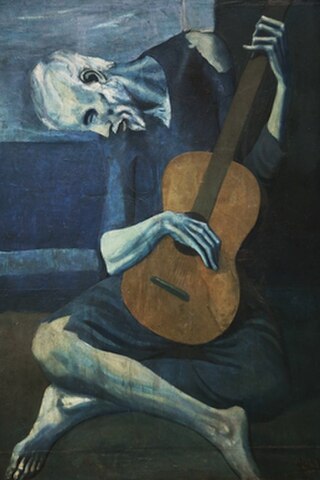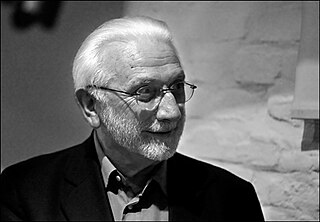
Georges Braque was a major 20th-century French painter, collagist, draughtsman, printmaker and sculptor. His most notable contributions were in his alliance with Fauvism from 1905, and the role he played in the development of Cubism. Braque's work between 1908 and 1912 is closely associated with that of his colleague Pablo Picasso. Their respective Cubist works were indistinguishable for many years, yet the quiet nature of Braque was partially eclipsed by the fame and notoriety of Picasso.

Pablo Ruiz Picasso was a Spanish painter, sculptor, printmaker, ceramicist and theatre designer who spent most of his adult life in France. One of the most influential artists of the 20th century, he is known for co-founding the Cubist movement, the invention of constructed sculpture, the co-invention of collage, and for the wide variety of styles that he helped develop and explore. Among his most famous works are the proto-Cubist Les Demoiselles d'Avignon (1907), and the anti-war painting Guernica (1937), a dramatic portrayal of the bombing of Guernica by German and Italian air forces during the Spanish Civil War.

Modern art includes artistic work produced during the period extending roughly from the 1860s to the 1970s, and denotes the styles and philosophies of the art produced during that era. The term is usually associated with art in which the traditions of the past have been thrown aside in a spirit of experimentation. Modern artists experimented with new ways of seeing and with fresh ideas about the nature of materials and functions of art. A tendency away from the narrative, which was characteristic for the traditional arts, toward abstraction is characteristic of much modern art. More recent artistic production is often called contemporary art or postmodern art.

Guernica is a large 1937 oil painting by Spanish artist Pablo Picasso. It is one of his best-known works, regarded by many art critics as the most moving and powerful anti-war painting in history. It is exhibited in the Museo Reina Sofía in Madrid.

Les Demoiselles d'Avignon is a large oil painting created in 1907 by the Spanish artist Pablo Picasso.

The Blue Period is a term used to define the works produced by Spanish painter Pablo Picasso between 1901 and 1904 when he painted essentially monochromatic paintings in shades of blue and blue-green, only occasionally warmed by other colors. These somber works, inspired by Spain and painted in Barcelona and Paris, are now some of his most popular works, although he had difficulty selling them at the time.

Picasso's African Period, which lasted from 1906 to 1909, was the period when Pablo Picasso painted in a style which was strongly influenced by African sculpture, particularly traditional African masks and art of ancient Egypt, in addition to non-African influences including Iberian sculpture, and the art of Paul Cézanne and El Greco. This proto-Cubist period following Picasso's Blue Period and Rose Period has also been called the Negro Period, or Black Period. Picasso collected and drew inspiration from African art during this period, but also for many years after it.

The Old Guitarist is an oil painting by Pablo Picasso, which he created in late 1903 and early 1904. It depicts an elderly musician, a haggard man with threadbare clothing, who is hunched over his guitar while playing in the streets of Barcelona, Spain. It is on display at the Art Institute of Chicago as part of the Helen Birch Bartlett Memorial Collection.

Ambroise Vollard was a French art dealer who is regarded as one of the most important dealers in French contemporary art at the beginning of the twentieth century. He is credited with providing exposure and emotional support to numerous then-unknown artists, including Paul Cézanne, Aristide Maillol, Pierre-Auguste Renoir, Louis Valtat, Pablo Picasso, André Derain, Georges Rouault, Paul Gauguin and Vincent van Gogh.

Lucien Clergue was a French photographer. He was Chairman of the Academy of Fine Arts, Paris for 2013.

The Dream and Lie of Franco is a series of two sheets of prints, comprising 18 individual images, and an accompanying prose poem, by Pablo Picasso produced in 1937. The sheets each contain nine images arranged in a 3x3 grid. The first 14, in etching and aquatint, are dated 8 January 1937. The remaining four images were added to the second printing plate later, without use of aquatint, and dated June 7, 1937.
Minotauromachy is a 19.5 by 27.4” etching and engraving created by Spanish artist Pablo Picasso in Paris in 1935. The etching and resulting prints, literally entitled Minotaur Battle, feature many compositional aspects and themes seen often in Picasso’s art throughout the 1930s. These include the Minotaur, an unconscious or dying female matador on an injured horse, a young girl holding a candle and flowers, a man scaling a ladder, and two women watching with doves from a window. Created during a time of personal turmoil within which Picasso created little artwork, Minotauromachy stands out as a seminal and striking piece with no shortage of artistic interpretations.

Aldo Crommelynck was a Belgian master printmaker who made intaglio prints in collaboration with many important European and American artists of the 20th century. At the time of his death, The Guardian termed Crommelynck the 'pre-eminent' and 'the most celebrated printmaker of the second half of the 20th century.'
Las Meninas is a series of 58 paintings that Pablo Picasso painted in 1957 by performing a comprehensive analysis, reinterpreting and recreating several times Las Meninas by Diego Velázquez. The suite is fully preserved at the Museu Picasso in Barcelona, it is known that he sold the first and second interpretations of the meninas to the American art collector Peggy Guggenheim, owner of the Art of this century gallery. This is a very extensive survey work which consists of 45 versions of the original picture, nine scenes of a dove, three landscapes and a portrait of Jacqueline.

The Vollard Suite is a set of 100 etchings in the neoclassical style by the Spanish artist Pablo Picasso, produced from 1930-1937. Named after the art dealer who commissioned them, Ambroise Vollard (1866-1939), the suite is in a number of museums, and individual etchings from the suite are collectible. More than 300 sets were created, but many were broken up and the prints sold separately.
Picasso's written works, that is, works created by Pablo Picasso, are often overlooked in discussion of his long and varied career in the mediums of painting, sculpture, drawing, collage, papier-mâché, (photography), assemblage, ready-mades, printing, ceramics and theatre designs. Despite being immersed in the literary sphere for many years, Picasso did not produce any writing himself until the age of 53. In 1935 he ceased painting, drawing and sculpting, and committed himself to the art of poetry; which in turn was briefly abandoned to focus upon singing. Although he soon resumed work in his previous fields, Picasso continued in his literary endeavours and wrote hundreds of poems, concluding with The Burial of the Count of Orgaz in 1959.

The Blue Guitar is a suite of twenty etchings with aquatint by David Hockney, drawn in 1976–77 and published in 1977 in London and New York by Petersburg Press.
Merrill Chase Galleries was an art dealership in Chicago, Illinois. It was started in 1964 by Robert Merrill Chase Sr., and his father, Merrill Chase. By 1978 it had more than 150 employees and 13 galleries, and was among the largest organizations of its kind in the United States.












